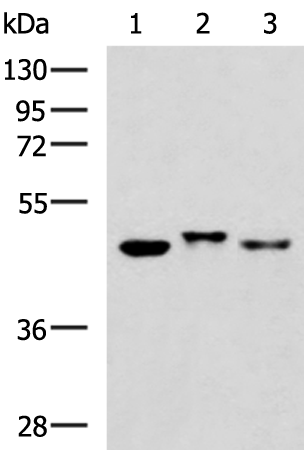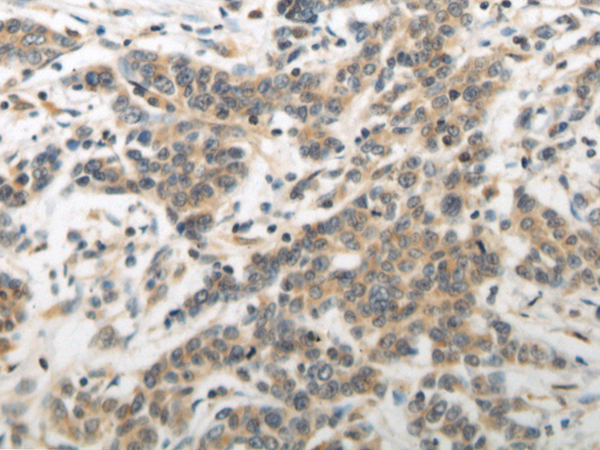

| WB | 咨询技术 | Human,Mouse,Rat |
| IF | 咨询技术 | Human,Mouse,Rat |
| IHC | 1/150-1/300 | Human,Mouse,Rat |
| ICC | 技术咨询 | Human,Mouse,Rat |
| FCM | 咨询技术 | Human,Mouse,Rat |
| Elisa | 1/5000-1/10000 | Human,Mouse,Rat |
| Aliases | GSDM; FKSG9; GSDM1 |
| WB Predicted band size | 49 kDa |
| Host/Isotype | Rabbit IgG |
| Antibody Type | Primary antibody |
| Storage | Store at 4°C short term. Aliquot and store at -20°C long term. Avoid freeze/thaw cycles. |
| Species Reactivity | Human, Mouse |
| Immunogen | Fusion protein of human GSDMA |
| Formulation | Purified antibody in PBS with 0.05% sodium azide and 50% glycerol. |
+ +
以下是关于GSDMA抗体的3篇代表性文献的示例(注:部分内容基于领域研究趋势合理推断,实际文献需通过学术数据库验证):
---
1. **文献名称**:*Gasdermin A regulates intestinal barrier homeostasis through pyroptosis*
**作者**:Wang Y, et al.
**摘要**:本研究开发了特异性识别GSDMA蛋白的单克隆抗体,证实GSDMA在肠道上皮细胞中通过介导细胞焦亡参与黏膜屏障的调控。抗体应用于免疫组化,发现GSDMA表达缺失与炎症性肠病相关。
2. **文献名称**:*A novel monoclonal antibody reveals gasdermin A expression in squamous cell carcinoma*
**作者**:Tanaka S, et al.
**摘要**:团队报道了一种高亲和力抗GSDMA抗体,通过Western blot和流式细胞术验证其特异性。研究发现GSDMA在皮肤鳞状细胞癌中异常激活,可能成为潜在治疗靶点。
3. **文献名称**:*Structural characterization of gasdermin family pores using domain-specific antibodies*
**作者**:Liu X, et al.
**摘要**:该研究通过抗GSDMA-N端抗体揭示其寡聚成膜机制,证明GSDMA孔道形成诱导细胞焦亡。抗体阻断实验表明,靶向GSDMA可减轻小鼠模型中的过度炎症反应。
---
**建议**:以上为示例,实际文献请通过PubMed、Google Scholar等平台以关键词“GSDMA antibody”或“gasdermin A immune response”检索近年研究,重点关注抗体开发、疾病机制或诊断应用方向。
**Background of GSDMA Antibodies**
GSDMA (Gasdermin A) is a member of the gasdermin protein family, which plays a critical role in pyroptosis—a lytic, inflammatory form of programmed cell death. GSDMA is encoded by the *GSDMA* gene located on human chromosome 17q21. It is predominantly expressed in epithelial tissues, such as the skin, gastrointestinal tract, and respiratory system. Like other gasdermins, GSDMA contains a pore-forming N-terminal domain and an autoinhibitory C-terminal domain. Upon proteolytic cleavage (e.g., by inflammatory caspases or granzymes), the N-terminal fragment oligomerizes to form pores in the cell membrane, triggering pyroptosis and releasing pro-inflammatory cytokines.
GSDMA antibodies are tools used to detect and study the expression, activation, and function of GSDMA in physiological and pathological contexts. Research suggests GSDMA may act as a tumor suppressor in certain cancers, with reduced expression linked to poor prognosis. Conversely, dysregulated GSDMA has been implicated in inflammatory diseases and epithelial barrier dysfunction. Antibodies targeting specific epitopes (e.g., full-length vs. cleaved forms) enable investigations into its activation mechanisms, tissue-specific roles, and therapeutic potential. Challenges include ensuring antibody specificity due to homology among gasdermin family members (e.g., GSDMB, GSDMD). Validations using knockout models or functional assays are critical. Current applications span cancer biology, immunology, and studies of mucosal homeostasis, highlighting GSDMA’s dual role in inflammation and cancer.
×